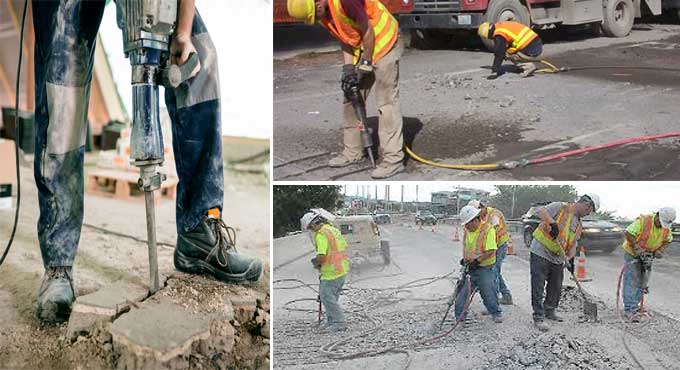Vibration risks in construction
At construction sites, vibrations brought on by construction activities might present serious
concerns. Vibrations can harm equipment, endanger the health and safety of site
employees, and have an adverse effect on the quality of the work done or the final product.
Business owners must be aware of these dangers to safeguard themselves from potential
legal actions and penalties. Construction supervisors and employees should be aware of the
risks posed by vibrations and how to reduce these risks.
What Effect Does Vibration Have on Construction Workers?
Construction workers may encounter a variety of symptoms when exposed to high vibration
levels. Certain bodily processes, such as the circulation of oxygen and nutrients throughout
the body and the general sensory input to the brain, can be interfered with. When body
tissues and cells receive fewer oxygen and nutrients, there is also a danger of cell death or
necrosis.
Back pain, headaches, and possibly the onset of carpal tunnel syndrome are some more
symptoms. Workers have occasionally shattered bones in their hands or feet because of
exposure to vibration at work.
Given how pervasive this problem has become in contemporary workplaces, the dangers of
vibration and the potential harm they might inflict are extremely alarming.
Types of Vibration:
Whole-Body Vibration (WBV): This occurs when the entire body is exposed to vibrations, typically from vehicle operation or machinery. Prolonged exposure can lead to health issues, including musculoskeletal disorders and lower back pain.
Hand-Arm Vibration (HAV): This occurs when hand-held tools or equipment transmit
vibrations to the hands and arms. Workers who regularly use vibrating tools like
jackhammers, chainsaws, or sanders are at risk of developing hand-arm vibration syndrome
(HAVS).
Health Effects:
HAVS: Prolonged exposure to hand-arm vibration can lead to HAVS, characterized by
symptoms like numbness, tingling, and reduced dexterity in the hands. In severe cases, it
can result in vascular and neurological disorders.
WBV-Related Health Issues: Whole-body vibration can lead to musculoskeletal problems,
particularly in the spine, and may contribute to chronic back pain. It can also affect the
digestive, cardiovascular, and reproductive systems.
Regulations and Guidelines:
Many countries have regulations and guidelines in place to protect workers from vibration
risks. For example, the European Union has established exposure action values and
exposure limit values for both HAV and WBV, which determine permissible levels of
exposure.
Risk Assessment:Employers should conduct risk assessments to identify potential sources of vibration and
assess the level of exposure. This assessment helps in implementing control measures to
minimize risks.
Control Measures:
Engineering Controls: These involve modifying equipment or processes to reduce vibration
levels. This can include using vibration-damping materials, maintaining equipment, and
using anti-vibration mounts.
Administrative Controls: These measures include scheduling breaks to reduce worker
exposure, rotating tasks, and providing training and education to workers about vibration
risks.
Personal Protective Equipment (PPE):
In some cases, PPE like anti-vibration gloves can help reduce the impact of vibration on
workers.
Training and Awareness:
Workers should receive training on the risks associated with vibration exposure, how to use
vibrating tools safely, and how to recognize the early signs of HAVS or other vibration-
related health issues.
Monitoring and Health Surveillance: Regular health checks and surveillance should be conducted for workers who are exposed to significant vibration to detect any health issues early.
Maintenance and Equipment Selection: Regular maintenance of machinery and equipment is essential to ensure they operate as efficiently as possible, which can help reduce vibration levels. Employers should also consider selecting low-vibration tools and machinery when feasible.
Record Keeping:
Employers should maintain records of vibration exposure assessments, worker training, and
health surveillance to demonstrate compliance with regulations and guidelines.
It’s essential for employers, workers, and regulatory authorities to work together to
minimize vibration risks in construction to protect the health and safety of workers on
construction sites. Compliance with regulations, effective risk assessments, and the
implementation of control measures are crucial in managing these risks.
Disclaimer: This content is provided solely for your review. Erusu Consultants takes no liability for this article. The reader is advised to form their own opinion. Please consult a Structural Engineer before making any final decisions.






